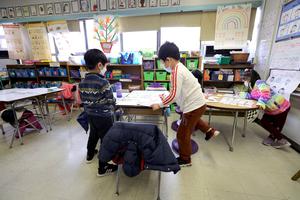Ash Wednesday Reset: Dioceses Prepare for More Typical Lenten Observance
While mindful of COVID protocols, plans are underway for pre-pandemic events and norms.

After last year’s ashes were coated on cotton swabs and sprinkled on parishioners’ heads, dioceses this year make plans to return to a more typical Ash Wednesday and Lenten season.
Priests from multiple dioceses told the Register they look forward to being able to return to pre-COVID practices.
The Diocese of Phoenix does not have any restrictions or pandemic-related suggestions regarding the distribution of ashes. Parishes will be able to adjust their practices to what will best suit their community, but according to director of the diocesan Office of Worship and Liturgy, Father John Muir, ashes will generally be applied in the typical, cross-on-the-forehead manner.
Father Muir told the Register the diocese expects to see the parishes progressing back to pre-pandemic practices. He described the sign of the cross in ash as a rich symbol, with multiple layers of meaning.
“It’s a reminder of our mortality. All of us are ‘Adam,’ ashes to ashes, dust to dust. We are all going to die,” he said. “Secondly, we’re configured to the cross of Christ, which is our path to eternal life. Finally, being marked on your forehead is biblical. We see it in the prophet Ezekiel and the Book of Revelation. All of the baptized share in Christ’s priesthood, so this mark, like the mark on the foreheads of Old Testament priests, can remind us of our Christian role of priest.”
The ashes being pressed in the form of a cross on foreheads remind Catholics of the chrism oil at their confirmation, he added.
“We have the dignity of uniting our daily sufferings to Christ’s,” Father Muir said. “Ultimately, all of the mortification and sacrifices of Lent should really make present these three things: our mortality, the life found in the cross, and the power of our Christian priesthood.”
In addition to a normal imposition of ashes, the Archdiocese of Los Angeles hopes to return to the tradition of foot washing during Holy Week, but with the knowledge that COVID-19 restrictions can change quickly.
The archdiocese, the largest in the United States, encompasses three counties, each of which has individual COVID-19 requirements that are subject to adjustment. Another variant, like the widespread infection of omicron, could cause parishes to be unable to proceed with an event like foot-washing during Holy Week. Those decisions will be made closer to the time of the events themselves.
“Many people who have not been to church for a long time usually come back for Ash Wednesday, even though Catholics are not obligated to go to Mass or receive the ashes,” Father Juan Ochoa, director of the archdiocese’s Office for Divine Worship, told the Register. “The whole purpose of receiving ashes is the significance of repentance. Back all the way to the Old Testament, people will not just put a sign of the cross, as we do now, but they will be covered in ashes as some form of repentance, of recognizing their sinfulness, but at the same time, being open to God’s mercy.”
He described openness to God’s mercy as seeking a new or fresh beginning. “Of course, because of the pandemic last year, the number of people who came was less than the previous years,” Father Ochoa said. “We do hope that this year the number of people that come in will be higher. But at the same time, we recognize that it will not be as it was before the pandemic.”
The Diocese of Springfield in Illinois plans for each priest to choose either applying ashes on the forehead or sprinkling them on the heads of parishioners, as was the protocol last year.
Director of Communications Andrew Hansen told the Register that parishes had adapted well to COVID-19 related changes over the past two years. In regards to the significance of the application of ash in the sign of the cross, he said, “For each individual person, it has different significance.”
The Archdiocese of Boston plans to drop its mask requirements the Monday preceding Ash Wednesday, in accordance with the state of Massachusetts relaxing its public-school mask requirements the same day. Parishes may individually determine how quickly they return to normal processions and other Holy Week events.
Father Paul Soper, secretary for the archdiocesan Secretariat for Evangelization and Discipleship, told the Register that his parishes will continue their tradition of keeping the church doors open for 24 hours on Ash Wednesday. Eucharistic adoration, the sacrament of reconciliation, and distribution of ashes will be available during that time.
By doing so, the parishes look to reach people who might not have planned to attend an Ash Wednesday service but may drive past the church and decide to stop in.
Father Soper said that while there’s much that should be reset, it’s important to ensure it consists of more than just the cultural and practical elements.
“Ash Wednesday is always the time for starting over again. We want to be certain [to have this spiritual mindset] because we’re doing a sort of big reset in our culture and day-to-day practices, which, in the end, are not nearly as important as our interior life, the state of our heart and relationship with God,” Father Soper said.
He hopes it will be a time of rebuilding ties and connections in the parish community, as well.
“We want to be sure that the reset is more fundamental than taking off our masks or going back to being with other people,” Father Soper said. “We want to be sure that it’s renewing our life of prayer, renewing our life of virtue, seeking new and appropriate ways of taking care of the poor.”
- Keywords:
- meghan schultz
- ash wednesday
- lent
- covid-19















